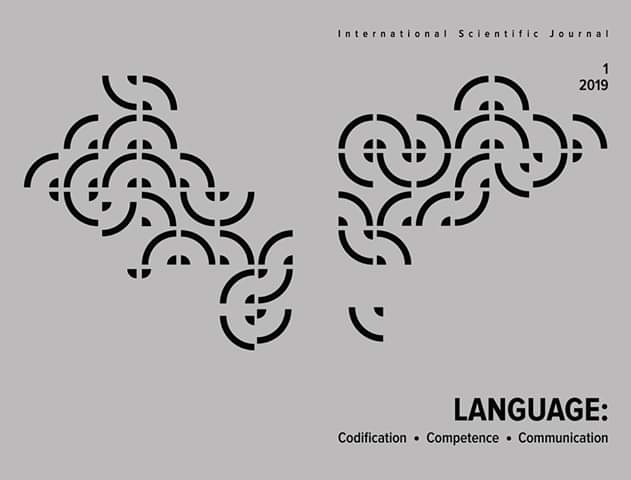COGNITIVE AND ONOMASIOLOGICAL RECONSTRUCTION OF ENGLISH AND GERMAN PHYTONYMS FORMED ACCORDING TO THE ASSOCIATIVE-TERMINAL TYPE OF MOTIVATION
DOI:
https://doi.org/10.24025/2707-0573.1.2019.169420Abstract
Background. Cognitive onomasiological analysis of language units is one of the most studied theories of linguistic science today, especially in the field of the study of phytonyms as a lexical-semantic class of language units. However, the mechanisms, according to which these names are generated, are still waiting to be explained, which, in its turn, will explain both the complex interrelations between the conceptual and linguistic levels, and processes of obtaining, processing and processing information that is acquired through sensual experiences. Therefore, the article is devoted to the comparative cognitive-onomasiological analysis of the evaluative semantic component of medicinal plants names.
Purpose. The purpose of this research is to establish the motivational base of German and English phytonyms with an evaluative semantic component belonging to the associative-terminal type of motivation and to reconstruct evaluative semantics that is inherent in the designator as a result of this type of motivation.
Methods. Cognitive-onomasiological analysis, cognitive reconstruction, onomasiological reconstruction, semantic reconstruction and comparative method.
Results. The study presents the results of the analysis of 520 names of medicinal plants in two languages of the Germanic group (German and English), onomasiological structures of which contain designators of associative-terminal type with evaluative semantics. It has been indicated that phytonyms with evaluative semantics are motivated by metaphorical signs borrowed from the donor areas such as “natural factor”, “person”, “animal”, “mythological creature” and “artefact”. Conceptual sphere “plant”, which is a part of the broader conceptual sphere “natural factor”, has the largest number of examples of use as a donor area. Correlations between different types of evaluative components and metaphoric donor spheres have been reconstructed.
Discussion. Comparing results of cognitive and onomasiological analysis of medicinal plants’ names in German and English revealed donor spheres and mechanisms of associative-terminal motivation, that are common for both languages. Metaphorical motivators have been indicated both in plants’ names motivated according to the associative-terminal type, and in those belonging to mixed motivation type. Since a comparative cognitive-onomasiological analysis of two closely related languages naturally reveals common tendencies rather than differences, we see prospects for further exploration in conducting a similar study with languages belonging to different groups and compare results for languages, that would be unrelated or distantly related.
Keywords: phytonym, evaluative component, cognitive onomasiological analysis, associative-terminal motivation, designator, donor sphere.
References
Аллафи, Л. М.-Р. (2014). Принципы номинации родовых названий лекарственных растений. Историческая и социально-образовательная мысль. 6 (3), Ч. 2, 41-45. https://doi.org/10.17748/2075-9908-2014-6-6_2-41-45
Анненков, Н. И. (1878). Ботаническій словарь. Санктпетербургъ: Типографія императорской академіи наукъ.
Арутюнова, Н. Д. (1999). Язык и мир человека. (2-е изд., испр.). Москва: Языки русской культуры.
Давыдов, Н. Н. (1960). Ботанический словарь. Москва: Главная редакция иностранных научно-технических словарей физматгиза.
Золотницкий, Н. Ф. (1999). Цветы в легендах и преданиях. Київ: Мистецтво.
Калько, В. В. (2003). Когнітивно-ономасіологічний аналіз назв лікарських рослин в українській мові (дис. ... канд. філол. наук: 10.02.01). Одеський національний університет ім. І. І. Мечникова, Одеса.
Колосова, В. Б. (2009). Лексика и символика славянской народной ботаники. Этнолингвистический аспект. Москва: Индрик.
Ортони, Э. (1990). Роль сходства в уподоблении и метафоре. В Н. Д. Арутюнова, М. А. Журинская (общ. ред.), Теория метафоры: сборник. (С. 219-235). Москва: Прогресс.
Панасенко, Н. И. (2009). Контрастивный анализ метафоры в фитонимической лексике. Нова філологія. 36, 128–135.
Ричардс, А. (1990). Философия риторики. В Н. Д. Арутюнова, М. А. Журинская (общ. ред.), Теория метафоры: сборник. (С. 219-235). Москва: Прогресс.
Сейдаметова, Н. (2013). Особенности ономасиологической структуры названий растений в крымскотатарском языке. Мова і культура. 16 (6), 198–204.
Селіванова, О. О. (2006). Сучасна лінгвістика: термінологічна енциклопедія. Полтава: Довкілля-К.
Селіванова, О. О. (2008). Сучасна лінгвістика: напрями та проблеми. Полтава: Довкілля-К.
Усик Л. М. (2017а). Донорська зона «натурфакт» у механізмі асоціативно-термінальної мотивації німецьких, англійських, російських та українських фітонімів. Проблеми зіставної семантики. 13, 238-246.
Усик, Л. М. (2017b). Когнітивно-ономасіологічна реконструкція оцінного компонента у семантиці фітонімів (на матеріалі назв лікарських рослин у німецькій, англійській, російській та українській мовах) (дис. ... канд. філол. наук: 10.02.17). Національний педагогічний університет ім. Н. П. Драгоманова, Київ.
Хатхе, А. А. (2011). Номинации растительного мира в когнитивном и лингвокультурологическом аспектах (на материале русского и адыгейского языков): Монография. Майкоп: Адыгейский государственный университет.
Bunney, S. (ed.) (1992). Illustrated Encyclopedia of Herbs, Their Medicinal and Culinary Uses. New York: Dorset Press.
Holl, F. (1833). Wörterbuch deutscher Pflanzen-Namen – oder, Verzeichniss sämmtlicher in der Pharmacie, Oekonomie, Gärtnerei, Forstkultur und Technik vorkommenden Pflanzen und Pflanzentheile. Erfurt: Keyser.
Kövecses, Z. (2010). Metaphor: A Practical Introduction. (2nd Ed.). New York: Oxford University Press.
Lakoff, G. (2006). Conceptual metaphor: The contemporary theory of metaphor. In D. Geeraerts (Ed.), Cognitive linguistics: Basic readings. Berlin: Mouton de Gruyter. 185-238.
Panasenko, N. (2015). Olfactory information processing channel in medicinal plants’ names (based on Germanic and Western Slavic languages). Proceedings from II International Scientific and Practical Conference “Science and Education – Our Future”. № 4(4), Vol. 3 (Dec 2015). Ajman, UAE. 34–42.
Downloads
Published
Issue
Section
License
Copyright (c) 2019 Language: codification, competence, communication

This work is licensed under a Creative Commons Attribution-NonCommercial 4.0 International License.
Authors hold full copyright and at the same time they transfer the publishing rights to the journal. The author of a published article has the right to distribute it, post the work in the electronic repository of his/her institution, publish as a part of a monograph, etc. with a required link to the place (output) of its first publication.
The authors confirm that the scientific article submitted for publication has not previously been published and has not been submitted to the editorial office of other journals.
If you have any questions, please contact us:
email: ukrmova@chdtu.edu.ua, o.pchelintseva@chdtu.edu.ua
Viber / WhatsApp: +38 093 789 09 27


